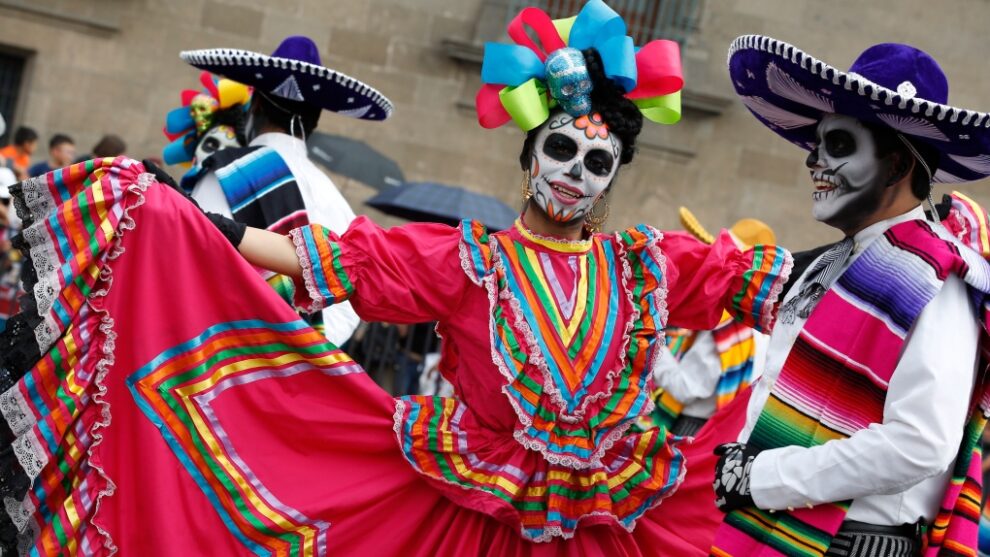In the U.S., where death is a taboo topic and funerals are somber affairs, it might seem strange for an American woman to build a towering, colorful altar honoring her departed husband at the entrance of the shop they once ran together. It’s like the altar is there to start conversation — one many people would rather avoid.
Last week, a couple shopping at Casa Ramirez asked the obvious, if uncomfortable, question: “Is that you and your husband?” The man pointed to a painting that showed Macario and Chrissie Dickerson Ramirez in a happy embrace. A milky white calavera, or sugar skull, loomed in the background.
More than four decades, to be exact. Macario, whose folk art gallery has long been a cultural pillar in the Heights, dedicated himself to championing Chicano causes and sharing his Mexican heritage with Houstonians of all backgrounds. His passion for Día de Muertos, Day of the Dead, drew the community’s attention from the beginning. At first, the flowery skulls, dancing skeletons and ornate ofrendas were met with raised eyebrows. Some were concerned it was a satanic ritual.
“He educated people and really made them understand, we’re in the minority of people that view death as an ending,” Charlotte Aguilar, a longtime friend of Macario’s, told the Chronicle. “That was a huge thing that he kept chipping away.”

Born and raised in San Antonio, Macario didn’t learn about the tradition from his immigrant parents, who, wanting to assimilate to the American culture, thought it best to leave those customs behind. It wasn’t until he visited his grandparents in Michoacán, in central Mexico, that he fell in love with the practice of honoring dead loved ones by celebrating the lives they lived, and doing it the Latin American way: with song, dance, sweet breads and lots of tequila.
But the joyful tradition can also be difficult. At Casa Ramirez, the community ofrenda became a unique place for Houstonians to process and mark deeply painful losses — to AIDS, gang violence, mass shootings. Macario often recommended that customers wait a year after a loss so they could build an ofrenda with the right headspace.
Each year, a rotating cast of community members get a designated space to set up individual ofrendas, accompanied by a one-pager telling the story of the person they’re honoring. This year, one features a young man rocking out on his guitar, white angel wings above him indicating he left this world too soon; at his feet lie a Pizza Hut box and a Mexican Coke bottle wrapped in a University of Houston sleeve. Another ofrenda honors a lawyer, his degree proudly displayed alongside a Houston Oilers pennant and several dusty Beatles records. And a third celebrates many family members, their black-and-white photos strung up alongside stars and monarch butterflies on a net against the wall, the Virgin of Guadalupe standing guard above them.

Each is unique, but there are recurring symbols. Three layers represent the underworld, Earth and heaven. The cempasúchil, or marigolds, attract the souls of the departed with their bright color and fragrance. And the monarchs, who journey 2,000 miles south each fall, are considered emblematic of souls briefly visiting their loved ones on Earth once more.

The roots of Día de Muertos go back 3,000 years to indigenous rituals in central and southern Mexico. The holiday many celebrate today is a syncretic blend of those indigenous traditions with Spanish Catholicism. But like Macario, I didn’t grow up celebrating it every first and second of November. In northern Mexico, where my family and I are from, the holiday isn’t as culturally engrained. In fact, just a couple of weeks ago, while visiting family in Monterrey, I noticed the Halloween decorations on people’s homes far outnumbered any sign of Day of the Dead.
For me the beginning of November means attending Catholic Mass on All Saints Day and praying for the faithful departed on All Souls Day. But as a writer, I’ve always been fascinated by the custom of building ofrendas as a way to tell and preserve the story of someone you love.
And sometimes it takes an outsider to help others see the beauty of their own culture. After “Spectre,” the 2015 James Bond movie, featured a rollicking Día de Muertos parade in Mexico City, the Mexican government decided to take the Hollywood invention and make it a reality. I was a high school student living in Mexico City at the time, and attended the inaugural parade in the city’s historic center with my parents. It was so packed that, out of safety, my dad hoisted me on his shoulders. Even then I could barely see the top of the skeletons teetering around on stilts.
From Pixar’s “Coco” to the sugar skulls that now line H-E-B shelves, Día de Muertos is increasingly mainstream. Part of that is commercial interest. But I’m heartened by the other part — the people like Chrissie Ramirez who have embraced the cultural tradition as their own, and the people like Macario who have ensured that the custom lives on.
Source : Huston Crhonicle











